How to properly prune forsythia?
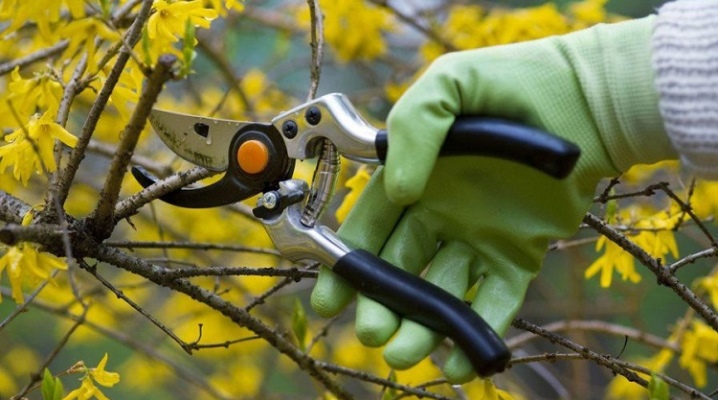
Bright color, unusual shape of flowers and amazing ability of forsythia to bend twigs beautifully cannot fail to attract the attention of gardeners. This shrub from the genus olive is able to create a unique landscape in any territory, but correct pruning is important for its beautiful appearance.

Why should you prune?
Forsythia needs pruning, even if decorative crown formation is not expected. If the gardener does not want to see bare thickets of leafless shoots in his area, he will have to form branches from time to time and remove damaged, old and diseased shoots. Of course, it is wiser to carry out all the necessary procedures in a timely manner, and this has good reasons.
- Since flowers only form on branches at the age of 2 years, no flower buds will form on other, more mature or younger shoots. This circumstance makes it necessary to constantly maintain two-year-old branches, while the lateral, lower large shoots and young shoots must be removed. Thus, a forsythia haircut is needed so that it blooms as magnificently as possible.
- The shrub is characterized by the rapid growth of new growth, and if not pruned periodically, it will look sloppy.
- Removing excess, weak and diseased branches helps to avoid diseases, including due to strong thickening and lack of natural ventilation.
- Pruning has the goal of stimulating the growth of new branches and is important for the health and rejuvenation of old shrubs.
- A haircut before the onset of winter cold is necessary to place the culture under a shelter - in the presence of long branches, this is much more difficult.
However, if you want to update the forsythia and improve its shape, you need to remove the branches with caution, and before wintering, do it in a sparing mode, so as not to injure and weaken the bush too much in anticipation of frost.
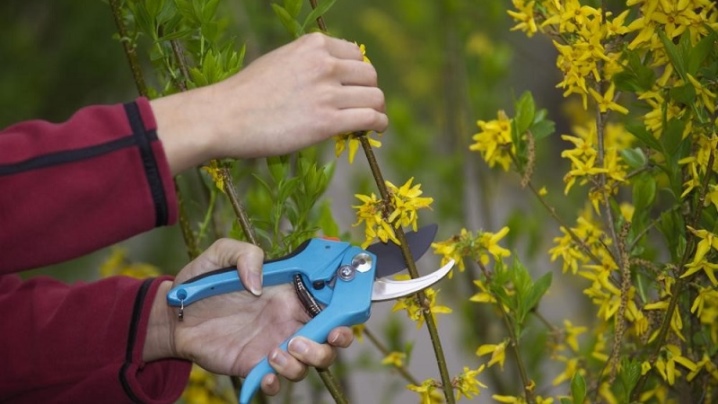
When is it better to do it?
There are three types of shrub trimming. Regular, held in the spring. It is aimed at forming a beautiful crown, and it is carried out immediately after flowering. Even if you want to leave the shrub in its natural state, the longest, improperly growing and damaged branches must be cut off, since they can significantly spoil the appearance of the plant, knocking out of the green massif of the crown. In other words, spring trimming is essential for the health and maintenance of a neat bush.
A radical rejuvenating haircut is necessary to exclude the chaotic interlacing of branches devoid of foliage, and the displacement of poor flowering to the periphery of the aboveground part of the shrub. This procedure is especially relevant for irregular pruning. Carrying out it is desirable in early spring, before flowering.
The first pruning involves cutting "to the stump" and keeping 2-5 of the strongest and healthiest branches. The next year, poorly developed shoots and grown shoots are thinned out, the remaining branches are shortened.
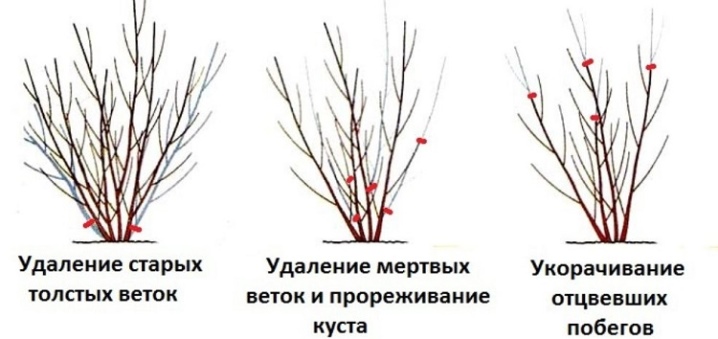
You can get a uniformly branched crown if you cut them to different lengths. Also in the second year, the abandoned old shoots are removed. A year later, forsythia takes on a beautiful appearance and usually blooms.
Summer pruning in June is used to create forsythia hedges. In this case, shoots are cut that violate the general appearance of the form.The main task of the procedure, carried out in summer, is to stimulate intensive growth in order to obtain a denser and denser crown, and the abundance of flowering is no longer in the first place.
Preparation for the winter includes pruning the plant in the fall - this is a certain guarantee of a successful wintering. Its technology is not overly complicated. First, they cut off dead, dry branches with damaged bark, as well as long branches that extend beyond the crown. After that, the lower branches are removed if there is no desire to obtain air layers.
At the end, it is necessary to cut off the shoots that grow towards the middle of the plant or intertwine with each other.
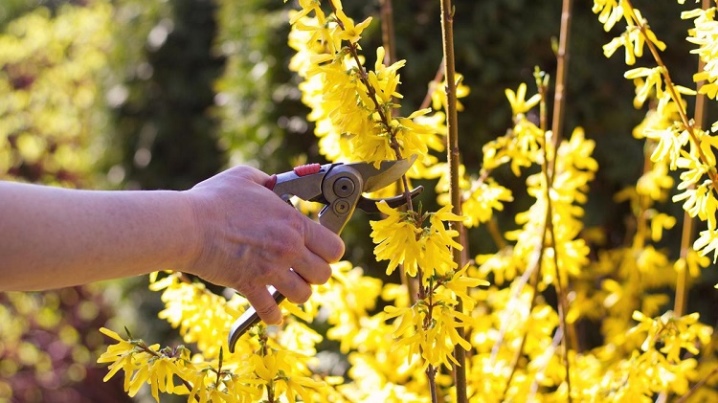
Required tools
To trim shrubs, including their decorative dwarf varieties, you need a well-sharpened, sharp tool that should leave even cuts. Before and during a haircut, it is important to decontaminate the metal with suitable antiseptics. If you use a dull, dirty blade, a fungus may develop at the cut site or another infection that can harm forsythia develops.
The main tools required for work are a garden pruner and a hand saw for wood or a delimber, shaped like scissors with long handles and considered the most convenient for such work. A hacksaw is needed if it is decided to cut off thick large branches. Before the procedure, you should take care of the presence of a garden varnish: large cuts that are formed on shoots 1.5 cm thick are lubricated with them. The cut material should not be thrown away: it can be useful as mulch, for high beds or compost. It is wiser to burn the branches affected by the disease in order to protect the rest of the plants in the garden.
Pruning - both in spring and summer and in autumn, should be carried out in the absence of sunlight, on a cloudy day, preferably during rain - this will exclude ultraviolet burns and the penetration of pathogenic flora.
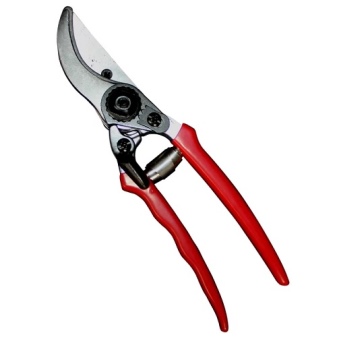
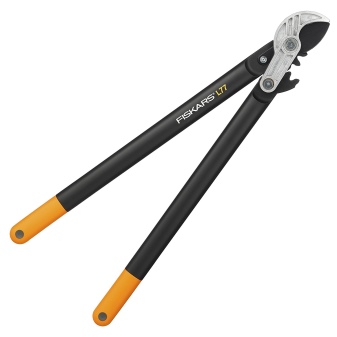
Subtleties of pruning
To make forsythia look natural and attractive at the same time, you need to know the basic rules for pruning this crop.
- The shrub requires a lot of space, so a place should be determined in advance where it can develop normally and reach its optimal size in adulthood. In this case, it is possible to correctly trim the plant.
- Basically, pruning is a way to make the shrub more compact and tidy, in addition to its decent appearance. It is believed that it is possible to form a ball from the crown by annually shortening the branches by a certain length. But, following this scheme, it will be impossible to get a beautiful spherical bush, because for successful wintering it is necessary to bend the branches to the ground due to freezing.
- In practice, it is possible to achieve a round shape much faster by removing the tallest as well as older shoots. Additionally, it is worth removing the lower branches, since they can often take root on their own.
- It is also necessary to cut off branches that grow incorrectly, inward, to the trunk, as well as specimens that interfere with each other due to strong thickening. This will allow you to achieve full coverage of the crown.
- It is sometimes difficult to do optimal pruning due to poor growth or heavy thickening. The best option is to cut the shrub "to the stump". Forsythia is perfectly restored by stump growth in one season, in addition, it contributes to the rejuvenation of the culture.
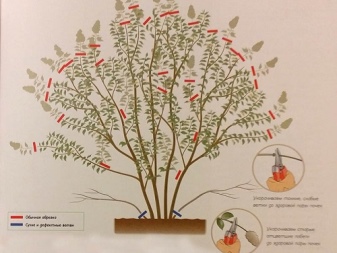
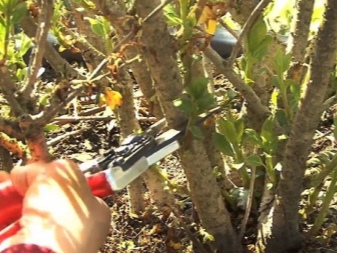
These rules are especially important for novice gardeners who do not fully understand how to prune shrubs correctly. Step-by-step instructions explaining the main stages of pruning will help to avoid mistakes:
- first, 1/4 of all old branches are completely removed;
- after that, dead dry shoots are cut off;
- those branches that have already faded must be shortened by 1/2 of the length;
- broken and damaged branches are cut 6-7 cm from the soil surface;
- to give a symmetrical shape, you need to cut the branches knocking out of the crown and trim them.
In the event that the plant will be used as a tapeworm (single shrub), it can be cut off after planting in a permanent place in the garden. First of all, it is important to remove the weakest branches.
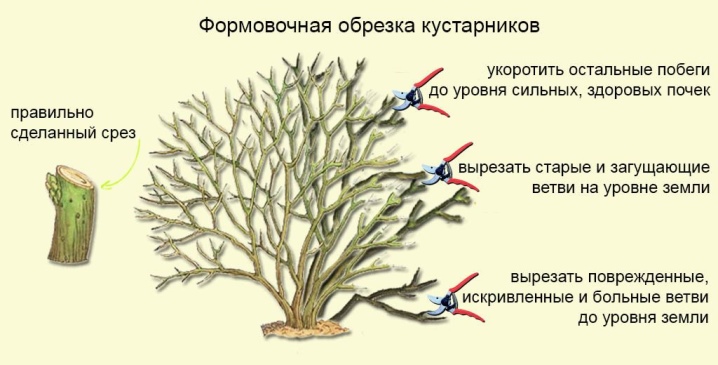
Follow-up care
Forsythia, in addition to pruning, needs constant care, and timely agrotechnical procedures contribute to its rapid recovery and abundant flowering.
- In March-April, after the snow melts, it is necessary to mulch the near-trunk circle of the bush with a large layer of humus and water it carefully so as not to erode the soil. This will keep the roots hydrated and at the same time receiving nutrients.
- After the buds appear, mineral fertilizing is introduced into the ground, and after the spring flowering, forsythia is fertilized with nitroammophos and selenium; you can also use the water-soluble composition of "Kimera Universal".
- August is the next month, when it is necessary to feed the plant with potassium and phosphorus compounds; for this, potassium salt and superphosphate (1: 2) are used.
- Watering forsythia in hot weather is associated with precipitation. In rainy weather, soil irrigation is not required, and on dry days, the bushes need to be watered once every 7 days. At least 12 liters of water are poured under each shrub.
- After autumn pruning in the middle lane and cold regions, the forsythia bush is generously watered, then the soil of the near-trunk circle is mulched with needles and fallen leaves with a layer of 10 cm.The branches of the plant must be bent to the ground and secured, and then covered with a non-woven cloth: agrofibre or spunbond. These materials allow the passage of air and moisture in a small amount, but necessary for the culture.
So, it becomes clear that for such an ornamental shrub as forsythia, pruning is necessary, and its timeliness allows not only maintaining the neat appearance of the plant, but also its healthy state.
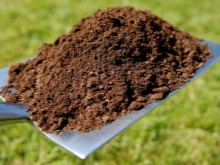

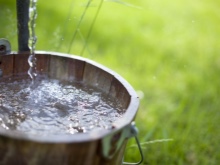
For information on how to properly trim forsythia, see the next video.






























































The comment was sent successfully.